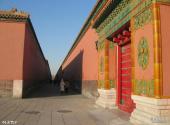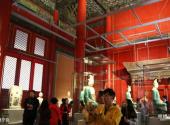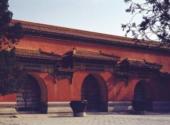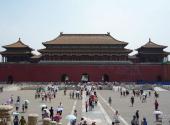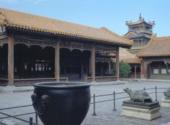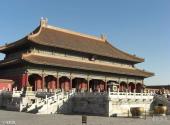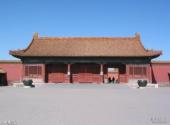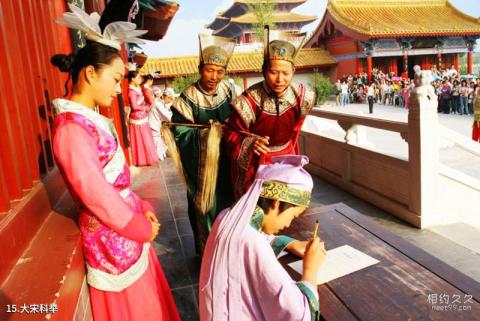
Scenic spot introduction:
Beijing Forbidden City It is one of the largest and best-preserved ancient wooden structures in the world. It is known as one of the five largest palaces in the world along with the Palace of Versailles in France, Buckingham Palace in the United Kingdom, the White House in the United States, and the Kremlin in Russia. Forbidden City Formerly known as the Forbidden City, its construction began in the fourth year of the Yongle reign of Emperor Zhu Di of the Ming Dynasty (1406 AD) and took 14 years to complete. It is the royal palace of 24 emperors of the Ming and Qing dynasties of China. It is also the essence of ancient Chinese Han court architecture and an unparalleled architectural masterpiece.The entire building is magnificent, solemn and gorgeous, all of which are made of wood, with yellow glazed tile roofs, blue-white stone bases, and decorated with magnificent paintings. The palace is surrounded by a 12-meter-high and 3,400-meter-long palace wall, in the form of a rectangular city, surrounded by a 52-meter-wide moat outside the wall, forming a castle with strict barriers. The palace is centered on the three major halls of Taihe, Zhonghe and Baohe, arranged along a north-south central axis, and spread out on both sides, straightening the north and south, and symmetrical on the left and right. This central axis not only runs through the Forbidden City, but also reaches Yongding Gate in the south and the Drum Tower and Bell Tower in the north, running through the entire city. It is magnificent, well-planned, and extremely spectacular.
Attractions distribution:
Forbidden City Located in the core of Beijing, between Tiananmen Square and Jingshan Park, it covers an area of 720,000 square meters, with a construction area of 150,000 square meters and 9,999 houses. Forbidden City The museum houses a large number of precious cultural relics. According to statistics, the total number is as many as 1,052,653, or 1 million cultural relics, accounting for 1/6 of the total number of cultural relics in the country. Forbidden City Some of the palaces in the Qing Dynasty have set up comprehensive history and art galleries, painting galleries, classified ceramics galleries, bronze ware galleries, Ming and Qing arts and crafts galleries, engraving galleries, toy galleries, study four treasures galleries, plaything galleries, treasure galleries, clock and watch galleries, and exhibitions of Qing Dynasty court statutes and cultural relics, etc. It houses a large number of ancient art treasures and is the museum with the richest collection of cultural relics in China.Scenic spot qualifications:
National 5A scenic spot, world cultural heritage, national key cultural relics protection unitScenic spot features:
Historical sites tours, cultural tours, family tours, museums, royal gardens, ancient buildingsScenic spot map:
Travel Notes of Travellers:
- Travel guide: The 100 most beautiful scenic spots in China!
- Travel Guide: Beijing Three-Day Travel Guide 2017
travelling guideline:
1. The Forbidden City is very large, with more than 9,000 palaces. It is almost impossible to visit it all in one day. Generally, tourists only visit the three main halls, the three back palaces, and the Imperial Garden. Basically, it can take half a day to visit from south to north. Tourists who have more time can go around the various palaces on the East and West Roads to have a closer look at the rare treasures on display.
2. All visitors can only enter through the "Meridian Gate" near Tiananmen Square, and cannot enter through other doors.
3. In exhibition halls such as the Treasure Hall, Clock and Watch Hall, Calligraphy and Painting Hall, etc., volunteers provide free explanations in Chinese and English.
4. There is no dedicated parking lot in the Forbidden City. The nearest public parking lots are outside Donghuamen, Jingshan Back Street and Beihai South Gate. Parking spaces are limited. Visitors are advised to choose public transportation.
5. From September 12 to 14, 2014, half-price tickets after 14:00 will be trialled, excluding thematic pavilions. The ticket price is 30 yuan and needs to be booked on the official website in advance; in October, you can purchase the 2015 Forbidden City Annual Pass on the official website for adults. 300 yuan, 150 yuan for the elderly and students. The ticket can be used to visit 10 times in a year, excluding visits to the museum.
6. Some new areas were opened in 2015, including: Meridian Gate Yanchi Tower and Duanmen Tower, the western area where Cining Palace, Cining Garden and Shoukang Palace are located, Donghuamen City Wall, Baoyun Tower, etc. Five projects in four major regions. The Meridian Gate and the Yanchi Tower will have huge cultural relics exhibition halls covering an area of 2,800 square meters. The Cining Palace will have a sculpture gallery. After the opening of the Donghua Gate Tower, the audience can visit about one-sixth of the wall of the Forbidden City. The Baoyun Tower will also display cultural relics from the Forbidden City. Collection.
Tour route:
Two-hour route: Meridian Gate → Taihe Gate → Hongyi Pavilion → Taihe Hall → Zhonghe Hall → Baohe Hall → Military Aircraft Department → Qianqing Gate → Qianqing Palace → Jiaotai Hall → Kunning Palace → Imperial Garden → Shenwumen ;
Half-day tour: Meridian Gate → Taihe Gate → Hongyi Pavilion → Taihe Hall → Zhonghe Hall → Baohe Hall → Military Aircraft Department → Yangxin Hall → Yongshou Palace → Taiji Hall → Changchun Palace → Yi Kun Palace → Chuxiu Palace → Xianfu Palace → Royal Garden → Kunning Palace → Jiaotai Palace → Qianqing Palace → Qianqing Gate → Fengxian Palace (Clock Hall) → Xiqing Gate → Nine Dragon Wall → Huangji Gate → Huangji Palace → Ningshou Palace → Changyin Pavilion → Yangxing Hall (Treasure Hall) → Ningshou Palace Garden (Qianlong Garden) → Leshou Hall → Summer Palace → Fuwang Pavilion → Zhenfei Well → Shenwu Gate
One-day tour: Meridian Gate → Xihe Gate → Wuying Hall → Xihe Gate → Taihe Gate → Hongyi Pavilion → Taihe Hall → Zhonghe Hall → Baohe Hall → Military Aircraft Department → Yangxin Hall → Yongshou Palace → Taiji Hall → Changchun Palace → Yikun Palace → Chuxiu Palace → Xianfu Palace → Imperial Garden → Kunning Palace → Jiaotai Palace → Qianqing Palace → Qianqing Gate → Fengxian Palace (Clock Hall) → Xiqing Gate → Nine Dragon Wall → Huangji Gate → Huangji Hall → Ningshou Palace → Changyin Pavilion → Yangxing Palace (Treasure Hall) → Ningshou Palace Garden (Qianlong Garden) → Leshou Hall → Summer Palace → Fuwang Pavilion → Zhenfei Well → Dongtongzi → Cangzhen Gate → Yan Xi Palace → Jingren Palace → Zhai Palace → Chengqian Palace → Yonghe Palace → Jingyang Palace → Zhongcui Palace → Qin’an Palace → Shenwumen
Best time to visit:
All seasons
Shopping recommendations:
Near Qianqing Gate, Imperial Garden, and Kunning Gate, restaurants, tea drinks, bookstores, and shops are concentrated. You can buy information books, picture albums, and handicrafts related to the Forbidden City.
Scenic spot map:
Scenic spot location:
China > Beijing > Xicheng District
How to get there:
South side ( Meridian Gate ) Admission: Metro Line 1, Tiananmen East or Tiananmen West Station; Bus No. 1, 2, 5, 10, 22, 82, 120, 37, 52, 59, 126, 90, 99, 203, 205, 210, 728, Special No. 1, Special No. 2, and get off at Tiananmen East or Tiananmen West Station.
North side Shenwu Gate and the east side Donghuamen , it is only an exit for visitors and is not suitable for entering for visitors.
Scenic area map:
Click to expand the scenic area map
Forbidden City Ticket Prices:
Peak season (April 1st – October 31st): 60 yuan/person
Off-season (November 1st – March 31st of the following year): 40 yuan/person
Treasure House Ningshou Palace Area (including the Opera House and Stone Drum House): 10 yuan/person
Clock and Watch Museum (Fengxian Temple Area): 10 yuan/person
Preferential measures: Children under 1.2 meters in height can visit for free with their guardians; retired cadres, disabled people and others can visit for free with their ID; primary, secondary and university students can visit at RMB 20 per person with their ID; seniors over 60 years old (inclusive) can enjoy half-price tickets with valid ID.
Holiday discounts: On Children's Day, children under 14 years old (including 14 years old) can visit for free, and one accompanying parent can enjoy a half-price discount. On Women's Day, female visitors can enjoy a half-price discount. On Army Day, active Chinese soldiers can visit for free with valid certificates.
Half-price discount (trial run from September 12 to 14, 2014): Admission after 14:00 on the same day is 30 yuan, excluding special halls. Half-day discount tickets are not sold on site and must be booked in advance on the official website.
Annual ticket (available for purchase in October 2014): 300 yuan for adults, 150 yuan for seniors and students, valid for 10 visits within a year, and will cease to be valid after the limit is reached. This ticket does not include the cost of visiting special museums, and each certificate can only be purchased once a year.
Themed free open days: The first Wednesday of every month during the off-season from 2014 to 2015 is free for teachers, medical staff, volunteers, active military personnel, public security police, and college students.
Scenic area opening hours:
[Peak Season] Ticket sales from 8:30 to 16:00, admission stops at 16:10, and the venue clears at 17:00;
[Off-season] Ticket sales from 8:30 to 15:30, admission stops at 15:40, and the venue clears at 16:30.
The museum is closed all day on Mondays, except statutory holidays and the summer vacation (July 1 to August 31 every year).


